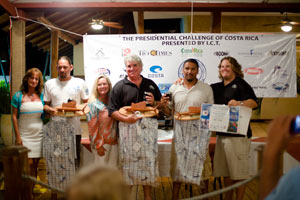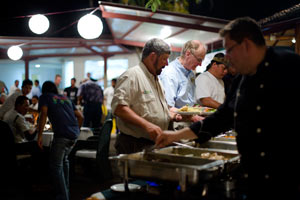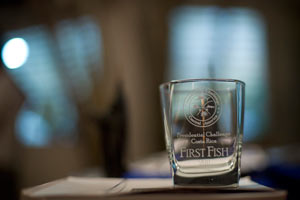For three full days, 33 anglers on 11 boats struggled with marlins and sailfish under the sweltering sun off the coast of Playa Carrillo. The team members looked exhausted by the time they were dropped off at the Villas Playa Samara resort just before dusk on Sunday March 27, but their spirits were high, still bantering and discussing the details of their exploits.
This concluded the 2011 Presidential Challenge of Costa Rica, the first of a four-part sports fishing tournament for billfish. All the fish are caught and released, and only circle hooks are allowed, to minimize damage to the fish. The next event will be held in June in the Papagayo peninsula, further north up the coast.
Many of the contestants headed straight for the bar and pool, sipping on drinks and eating fried chicken wings while waiting for the awards ceremony and dinner to begin.
Michael Viveiros of North Carolina was among the first anglers to head to the pool. “Today was excellent,” he said. “I caught two blue marlins and six sailfish.” According to contest rules, marlins are worth 300 points and sailfish are worth 100. Viveiros’s team OTX finished in third place with 1,800 points, while Las Ventanas del Mar won second place with 2,100.
Sea Angel captured the first prize with 3,200 points. They have competed in Presidential Challenges for the past seven years, and the captain, B.C. Angel, is only 26 and has been fishing competitively since he was 12. |
|

The winning team, Sea Angel after they received their awards. |
| |
|
| |

The award that was given to the team which took the second place. |
With B.C.’s father Greg Angel at the cockpit and Arturo Moreno and Federico Ortega as the additional anglers, the Sea Angel finished with two blue marlins and 26 sailfish.
“This tournament had some of the better fish I’ve seen in two years,” B.C. Angel commented.
According to the official press release, a total of 115 billfish were caught and released- including 20 blue marlin, five striped marlin and 90 sailfish.
There is no monetary reward for the Presidential Challenge, but winners of each event win prizes and receive an invitation to the prestigious IGFA Offshore World Championship Tournament in Cabo San Lucas, Mexico. The money that the contestants pay to enter is donated to The Billfish Foundation, a non-profit organization that is aimed towards conservation of billfish, and also a sponsor of the tournament.
According to co-organizer Sam White, Joan Vernon started the tournament 15 years ago to promote sports fishing in Costa Rica, boost the tourism industry and also demonstrate the importance of conservation to governments in Central America. A study done by the University of Costa Rica and sponsored by The Billfish Foundation shows that sports fishing brought about 600 million US dollars to Costa Rica’s economy in 2008 alone.
White said that they named the tournament “Presidential” to sound more prestigious. “Our original intent was to get government officials to come down and fish,” White said. “We hoped they would be able to see the impact.”
The Presidential Challenge became the first tournament in the world to enforce the use of circle hooks, and now the Costa Rican government has adopted a circle hook and catch-and-release policy for all sports fishing activities in the country.
Peter Chaibongsai, Director of Science & Policy for the Billfish Foundation, said that using circle hooks and employing a strict catch-and-release policy is economically beneficial in the long run. “The fish can be a renewable resource – it can be used over, over and over,” Chaibongsai said. “One fish can bring money back to the area.”
One of the foundation’s programs is Tag and Release, where they work closely with sports fishers to tag billfish in order to further study their life patterns. Chaibongsai said that the information gathered could be used to steer government policy – by demonstrating the impact of sports fishing on the economy. “It’s not only for science,” he added.
However, there is no tagging in this particular tournament. “They’re trying to get as many as they can,” Chaibongsai said. “If they’re inexperienced in tagging, they could tag them in the eyeball or the head.”
In addition to the crew and anglers, each boat has a rotating certified observer who is also in charge of keeping both fish and people safe. |
|

A dinner was served along with the award ceremony. |
| |
|
| |

The award that was given to the team which took the second place. |
“We’re not there to disqualify people, we’re there to help the team from making errors,” observer Bill Slaughter said. For example, he said that nobody is allowed to touch the rod or reel besides the angler when a fish is caught. They also make sure the hooks are right so the fish are not hurt.
On tournaments like these, accidents do happen and the crew needs to know how to react. “Yesterday they hooked up a marlin that ran straight towards the boat,” Slaughter said. “It was a foot out of the water.” Luckily, nobody was hurt, but the fish could break their bills if they rammed into the boat. Sluggish fish also cannot be released right away. “We hold them, drag them along, until they are revived,” Slaughter said.
Another observer George Crawford noted that in four years of observing, he has never known of fish dying. Chaibongsai said that according to studies, the survival rate of released fish using circle hooks is 85 to 90 percent.
Herbert Nanne, The Billfish Foundation’s Conservation Director of Central America said that many people still have a misunderstanding of what exactly constitutes a catch and release. “It’s not bringing it to the boat then releasing it,” he said. “When you put the fish overboard it still damages it.” He is currently working with local NGOs to produce brochures and educational DVDs.
Meanwhile, sport fishers have embraced the benefits and challenges of the circle hook and catch-and-release policy. “It’s the only way to go,” B.C. Angel said. “It also increases competition because circle hooks make it harder.”
Han Cheung is a journalism graduate student at the University of Missouri. His work has been published in the Columbia Missourian, San Diego City Beat, Vision Magazine and The Panama News.
| 
